Think about you’re throwing a celebration. You spend hours curating the proper playlist, lay out mouthwatering snacks, and clear the toilet (even behind the bathroom). However your first visitors stroll in, look round, and head proper again out the door. No goodbyes, nothing! Simply…gone. Brutal.
That, in a nutshell, is what a excessive bounce price appears like in your web site.
Bounce price measures the proportion of people that go to a web page in your web site after which depart with out clicking, scrolling, or participating. In different phrases, they arrive, they see, they ghost.
Whereas a excessive bounce price isn’t all the time a trigger for panic (extra on that in a minute), persistently excessive bounce charges is usually a crimson flag. They sign that your web site could be complicated, irrelevant, gradual, or simply not giving individuals what they anticipated to seek out.
The excellent news? Fixing bounce price points normally doesn’t require rebuilding your complete web site. With just a few sensible, strategic tweaks, you’ll be able to encourage guests to remain, discover, and interact.
This information walks you thru precisely what bounce price is, the best way to verify it, what benchmarks to goal for, and the best way to cut back it with sensible, easy-to-implement methods that work. It doesn’t matter what you’re engaged on, we’ll show you how to flip these bounces into longer visits and higher outcomes. Let’s dive in.
What Is a Bounce Price (and Why Does It Matter)?
Bounce price is a metric that reveals the proportion of tourists who land on a single web page of your web site after which depart with out taking any motion —no clicks, no scrolling, no type fills.
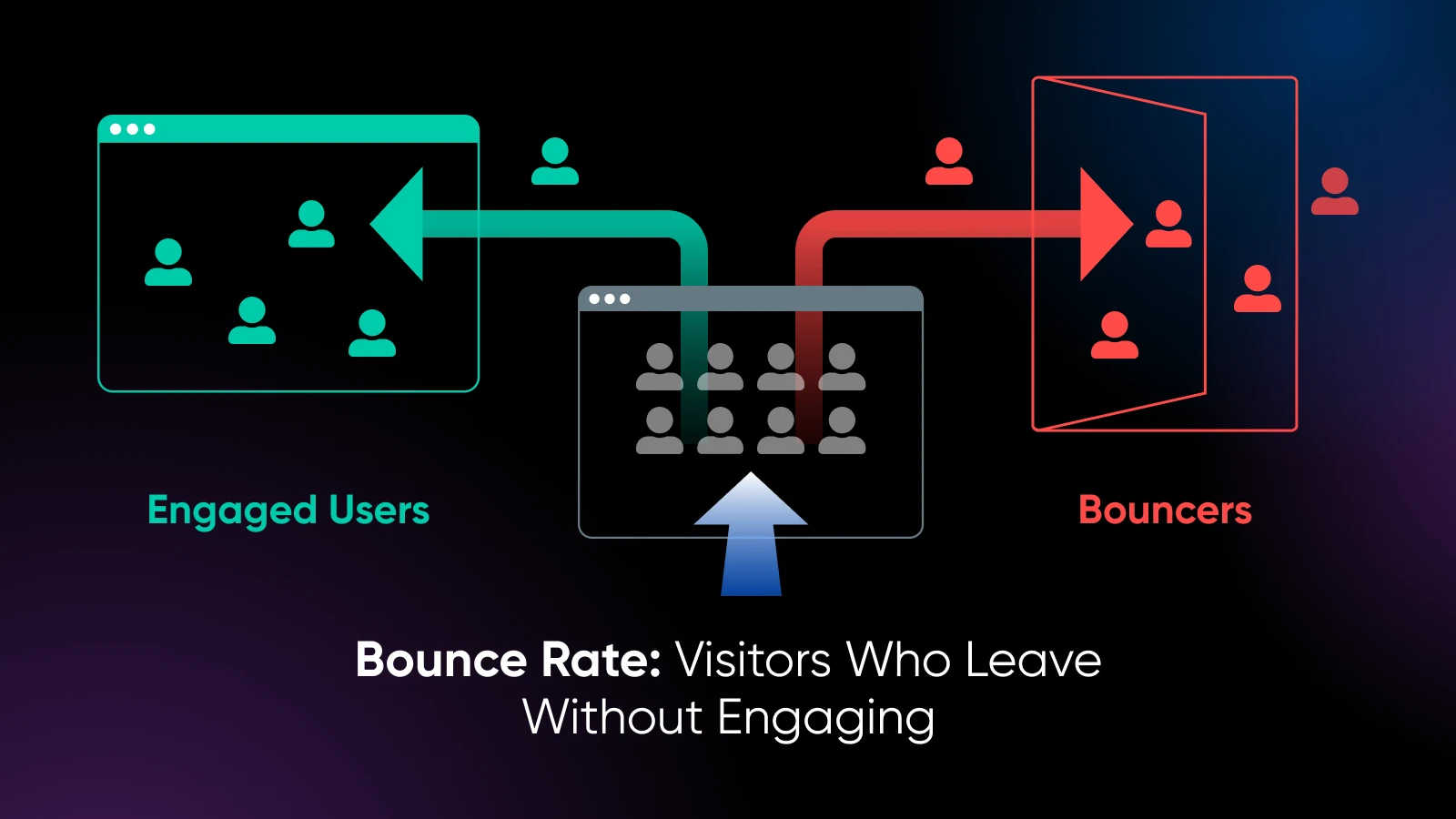
For instance, if 100 individuals go to a product web page and 65 depart with out clicking anything, that web page has a 65% bounce price.
Nonetheless, there’s nuance right here. A bounce doesn’t all the time imply content material or a web page has failed. For instance, say somebody searches for a selected query, lands in your weblog publish, finds their reply, and leaves glad. That’s technically a bounce, however not a nasty expertise.
Your objective shouldn’t be zero bounces; it needs to be ensuring that essential pages — like your homepage, touchdown pages, or pages that considerably contribute to your gross sales funnel — do their job of guiding individuals deeper into your web site or towards a conversion.
Understanding bounce price offers you perception into what’s working, what’s not, and the place you could be shedding individuals. And as soon as you understand that, you can begin fixing potential points to spice up engagement and conversions.
How To Test Your Bounce Price
Monitoring your bounce price begins with the best instruments. Two well-liked, beginner-friendly choices are Google Analytics 4 (GA4) and Google’s Website Equipment plugin for WordPress.
Utilizing GA4
GA4 doesn’t show bounce price by default. As a substitute, it reveals you a metric it calls “engagement price,” which is the inverse of bounce price. However your bounce price continues to be obtainable; you simply should allow it manually.
Right here’s what to do:
Log in to your Google account.
Choose your web site property.
On the left sidebar, go to Studies > Engagement > Pages and screens.
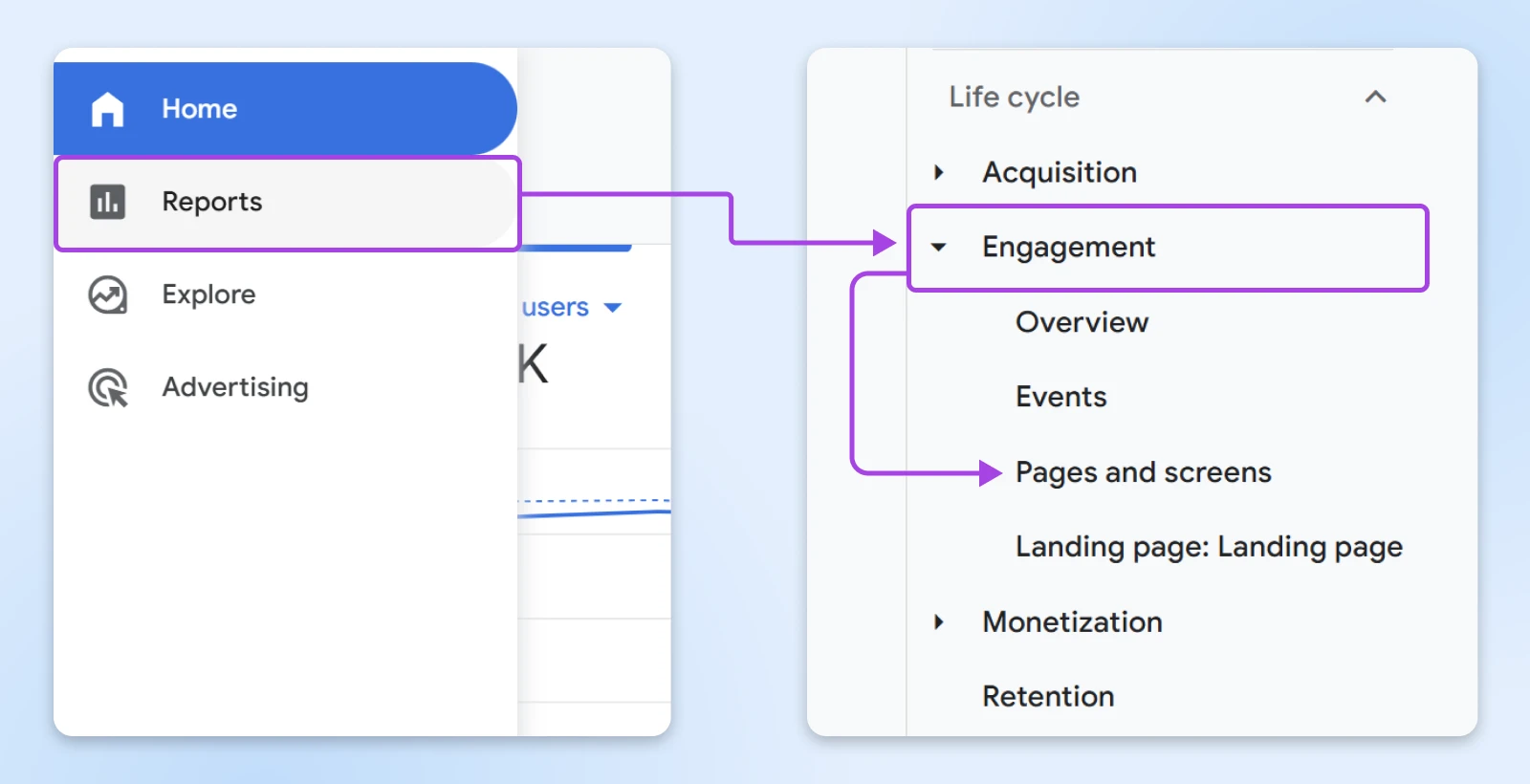
Click on the pencil icon within the prime proper nook of the report (Observe: You may solely customise a report in case you are an Editor or Administrator. If you happen to don’t see the pencil icon, you don’t have an Editor or Administrator position).
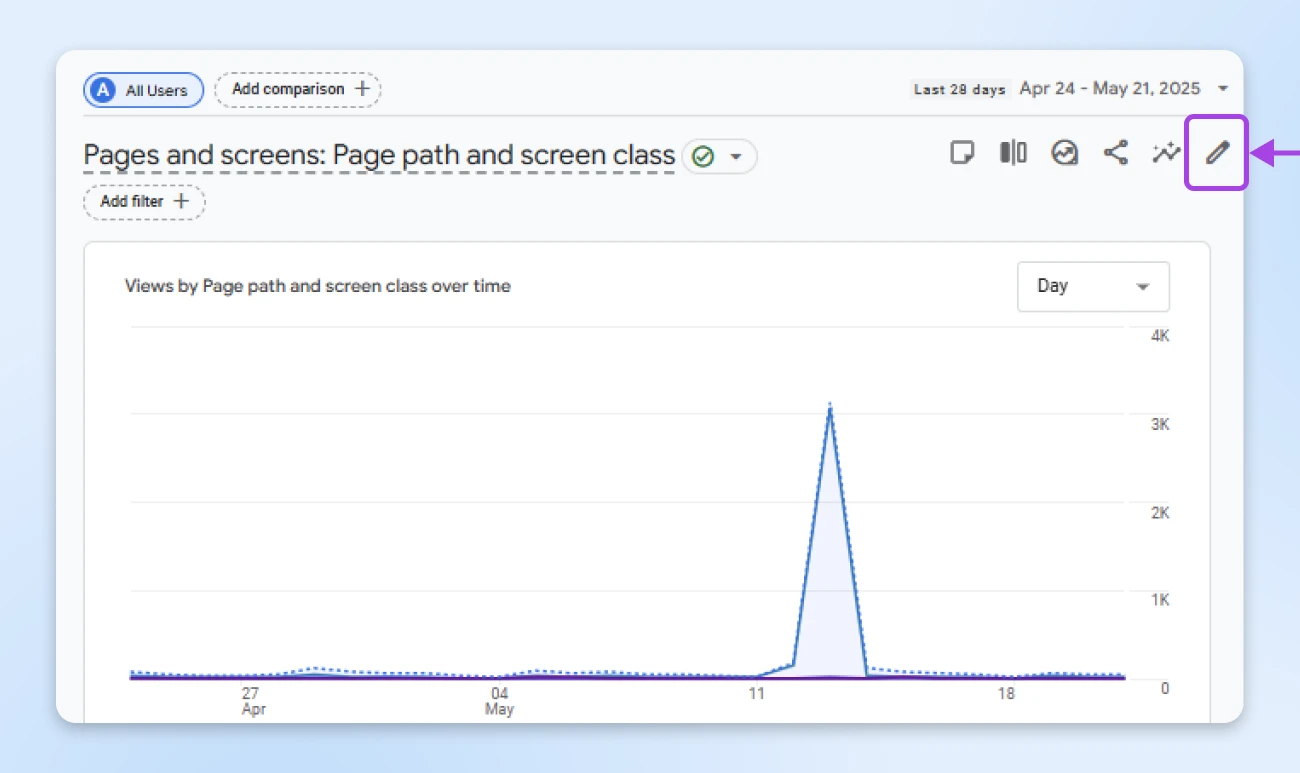
Within the customization panel on the best, click on Metrics.
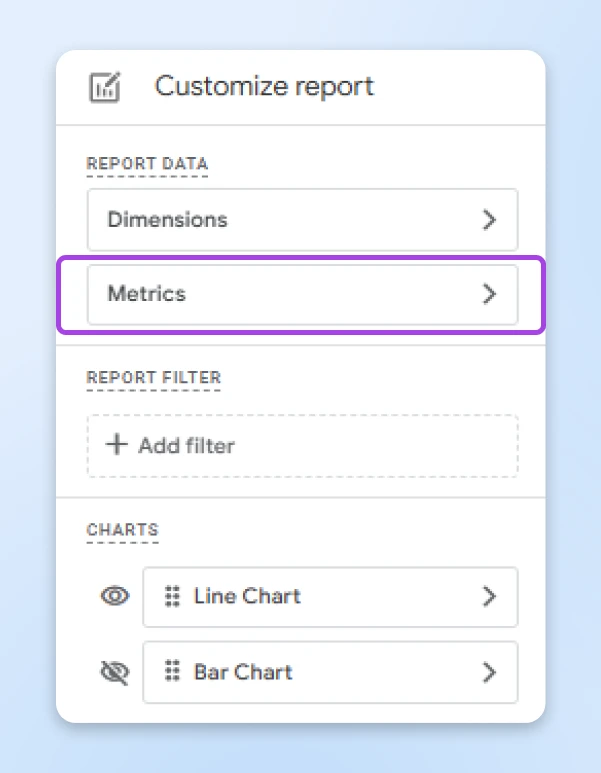
Seek for Bounce price, add it to your seen metrics, and hit Apply.
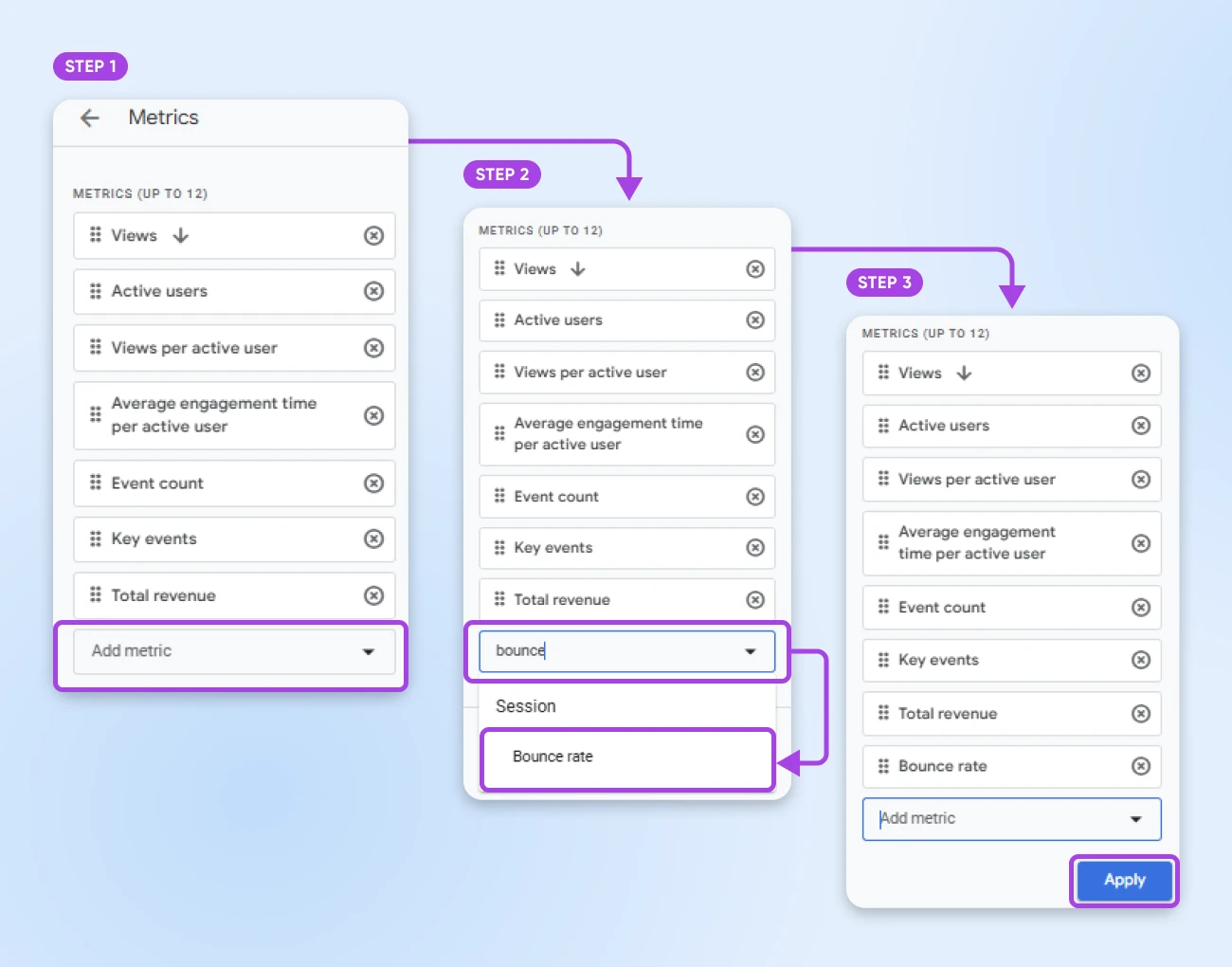
Save your modifications by clicking Apply.
Now you’ll be able to observe bounce price alongside different efficiency metrics.
Utilizing Website Equipment (for WordPress Customers)
If you happen to’re working a WordPress web site and desire a less complicated, extra visible answer, Website Equipment might be an possibility. Observe that it doesn’t straight show bounce charges, however there are just a few methods to deduce them from different metrics.
Right here’s what to do:
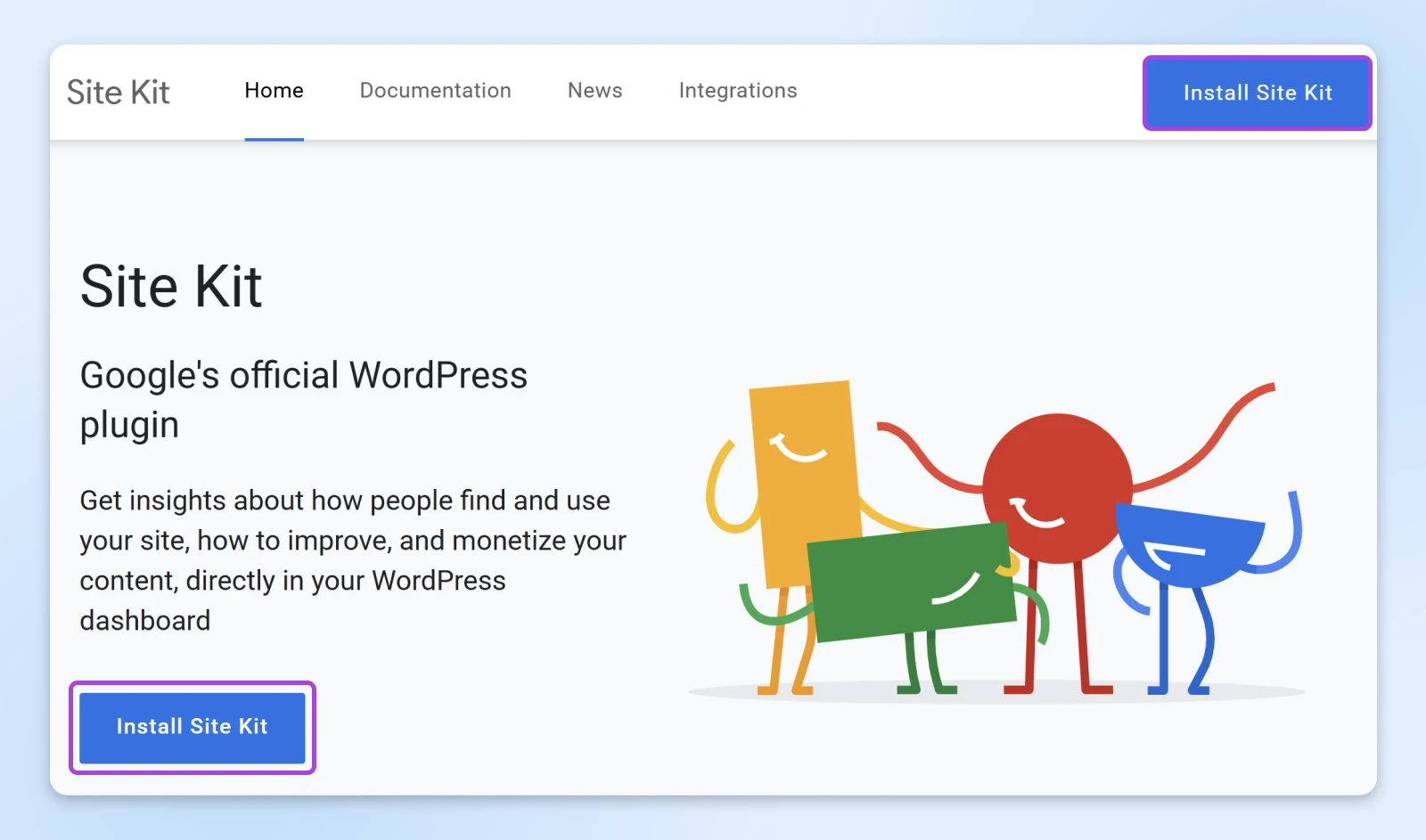
- Set up the Website Equipment plugin by Google
- Join it to your Google account and select your web site
- Out of your WordPress dashboard, go to Website Equipment > Key metrics
When you’re within the Key Metrics tab, you’ll see a tile known as Least Partaking Pages. It makes use of the bounce price metric (together with display screen web page views) from GA4 to calculate the least participating pages in your web site.
One other option to approximate bounce price in Website Equipment is to verify the Content material part and search for Engagement Price by web page. In GA4, engagement price is the inverse of bounce price. So you can approximate bounce price by subtracting engagement price from 100.
What’s a ‘Good’ Bounce Price?
There’s no single bounce price that each web site proprietor ought to try for. What counts nearly as good relies upon closely in your web site kind, content material, trade, viewers habits, and tons of different components.
That mentioned, trade benchmarks show you how to perceive what’s regular and what’s not. Listed below are some common pointers to provide you a place to begin, however you’ll seemingly wish to analysis some extra particular benchmarks in your trade:
- Below 20%: One thing is mistaken along with your analytics
- 20–40%: Wonderful (normally seen on service websites or product-focused pages with clear subsequent steps)
- 41–55%: Common
- 56–70%: Larger than common, might have enchancment
- 70%+: Potential crimson flag, particularly if these are touchdown or conversion-focused pages
A number of issues to concentrate to as you discover your baselines:
- Which pages have the best bounce charges? These are the primary pages you must take into account for optimization targets.
- How does bounce price fluctuate by visitors supply? For instance, individuals coming from natural search might behave otherwise than these from paid advertisements.
- What’s the common time on web page for high-bounce pages? This might help you distinguish between “dangerous” bounces versus “I obtained what I got here for” guests.
Additionally, have in mind:
- Blogs and content-heavy pages are likely to have greater bounce charges (particularly if customers discover what they want shortly and depart).
- E-commerce product pages usually have decrease bounce charges as a result of customers click on round to browse or evaluate.
- Marketing campaign touchdown pages ought to goal for the bottom bounce charges, because you need customers to take motion.
However do not forget that bounce price is only one metric, a single piece of a bigger puzzle. Mix it with common engagement time, scroll depth, and conversion price to get a fuller image of what’s actually taking place in your web site.
10 Methods To Scale back Bounce Price
Now that we’ve got visibility on bounce price, how will we enhance it? Listed below are 10 confirmed methods to cut back bounce charges and maintain guests engaged in your web site.
1. Match Customer Intent
Bounce price goes up when there’s a mismatch between what a customer expects and what they discover. For instance, when you place an advert that guarantees “handmade candles below $10,” however your touchdown web page sells luxurious present containers beginning at $60, you’re setting your self (and potential prospects) up for disappointment.
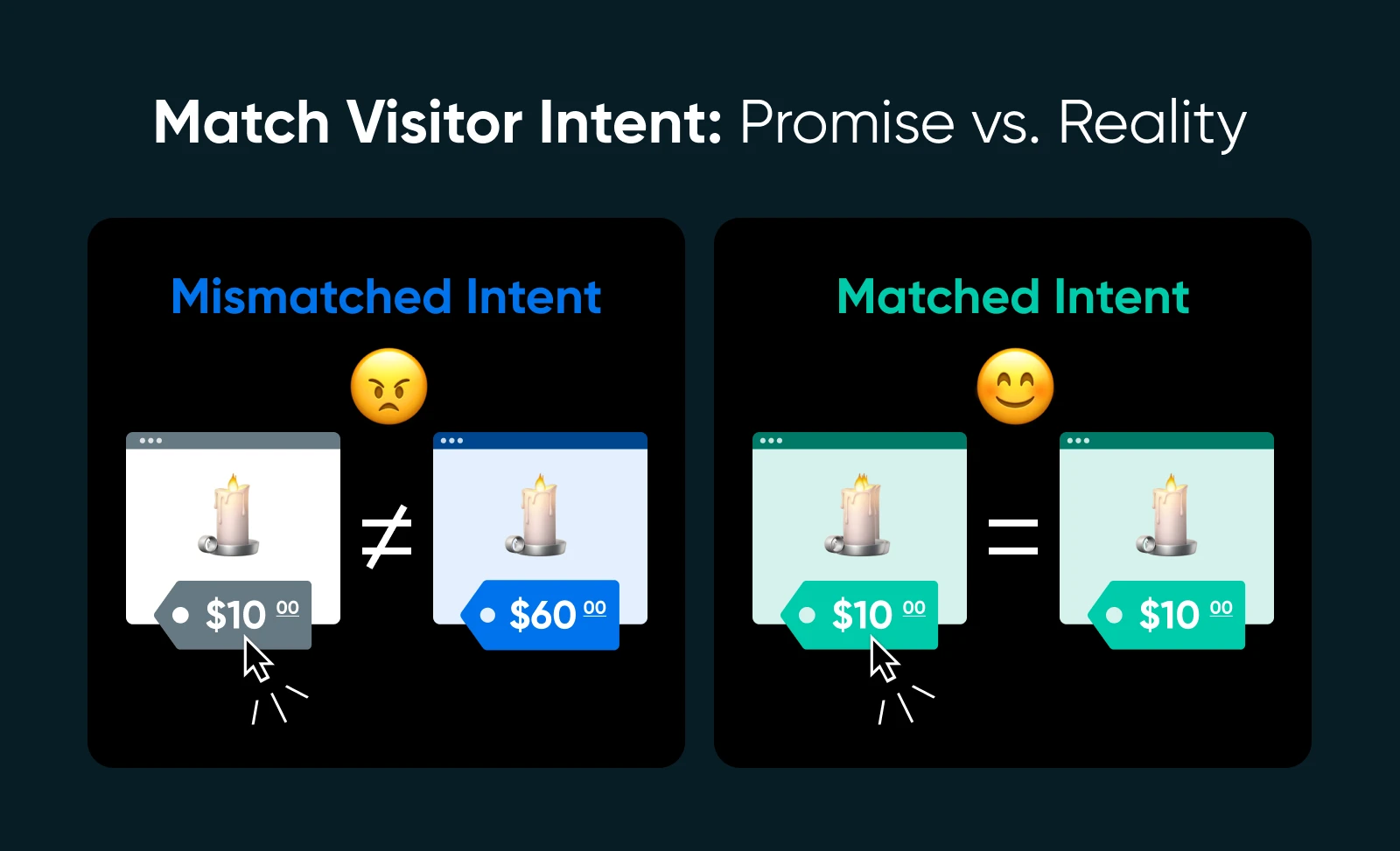
The underside line: When your content material meets guests proper the place they’re — answering their questions, acknowledging their ache factors, or delivering precisely what they clicked for — you dramatically enhance the probabilities they’ll stick round.
What to do:
- Begin by reviewing your prime visitors sources (natural, paid, social, and so on.) and inspecting what individuals seek for or click on on.
- Be certain that your web page content material displays the language and expectations set in your search consequence, advert, or e-mail. Headlines, subheads, and above-the-fold content material ought to align exactly with the promise made earlier than the clicking.
- Use heatmaps or consumer session instruments like Contentsquare to see the place individuals cease participating.
2. Make Positive Guests Know They’re within the Proper Place
Guests ought to instantly really feel oriented. In 5 seconds or much less, they need to perceive who you might be, what you provide, and what they need to do subsequent. If it’s not instantly clear, they could make a quick exit.
The underside line: Your above-the-fold content material ought to do three issues: Say what the web page is about, present what the customer can do subsequent, and reassure them that your web site is reliable and related.
What to do:
- Craft a transparent, concise headline that communicates what your web page is about in plain language. Assume “Get a Free Web site Audit Right this moment” as a substitute of “Digital Expertise Enhancement Options.”
- Use subheadings to strengthen the worth of the web page. A superb subhead anticipates a customer’s subsequent query.
- Assist your copy with imagery that displays your viewers or providing. A photograph of your precise product or crew builds extra belief than a generic inventory photograph.
- Add visible belief indicators like rankings, testimonials, and logos of publications or prospects, particularly when you’re asking for one thing in return.
3. Enhance Inside Navigation
When your web site construction is complicated, individuals depart —not as a result of they’re uninterested, however as a result of they will’t discover what they’re on the lookout for. Your navigation and menu design ought to act like a useful tour information, not a choose-your-own-adventure gone mistaken.
This instance reveals how Give Me Glow gives consistency of their menu by categorizing and utilizing arrows to point drop-downs for extra menus.

The underside line: Improved navigation encourages exploration, lowers friction, and helps information individuals to the solutions, merchandise, or info they’re on the lookout for.
What to do:
- Preserve top-level menus quick and intuitive. Group associated objects below logical classes (e.g., “Merchandise,” “About,” “Assist”) and keep away from clever-but-confusing labels like “Options Hub.”
- Add contextual inner hyperlinks inside your content material. For instance, when you point out WordPress in a weblog publish, present a hyperlink to your WordPress internet hosting web page.
- Use sidebar menus, breadcrumbs, or sticky nav bars on longer pages so customers can simply transfer round.
- Be certain that your navigation is mobile-friendly and doesn’t rely solely on hover-based dropdowns.
4. Add Sturdy Calls to Motion (CTAs)
Bounce charges usually spike when guests aren’t positive what to do subsequent. So in case your guests aren’t taking the following step, it could be since you’re not telling them what it’s. A CTA is your likelihood to information individuals towards one thing significant, whether or not that’s a sign-up, a sale, or simply studying the following weblog publish. Ask your self, what would you like this customer to do subsequent? Then make that possibility clear, compelling, and simple to behave on.
The underside line: A superb CTA respects the consumer journey and gives a logical, low-friction subsequent step that feels pure, not pushy.
What to do:
- Use lively, particular language. “Obtain the free information,” “Begin your 14-day trial,” or “Discover pricing” are far more efficient than “Be taught extra.”
- Match the CTA with the web page’s goal. On an informational web page, a “Learn subsequent” CTA works higher than a gross sales pitch. On a product web page, “Add to Cart” or “View Plans” is extra acceptable.
- Design your CTA to face out visually with out overwhelming the remainder of the web page.
- Place CTAs strategically all through the web page, not simply on the finish. Heatmaps and A/B testing might help you discover the best spots. Think about including sticky CTAs or buttons that seem after somebody scrolls 50% down.
5. Make Your Content material Extra Readable
Your content material could be good,but when it’s laborious to learn (for instance, buried in dense paragraphs with no visible breaks or missing in accessibility options), most individuals received’t stick round to learn it.
Guests are likely to scan moderately than learn word-for-word, so formatting and construction are simply as essential because the writing itself. Clear, skimmable content material helps customers discover the information they’re on the lookout for quicker,lowering frustration and (you guessed it) bounce charges.
The underside line: Enhancing readability helps individuals have interaction along with your content material, retaining them on the web page longer and lowering bounce.
What to do:
- Use quick paragraphs (2–4 strains max). Large partitions of textual content are intimidating, particularly on cellular.
- Break up your content material with subheadings each 200–300 phrases to assist information readers by way of the web page.
- Use daring textual content, lists, and callout containers to spotlight key info.
- Intention for an Eighth-grade studying stage. Instruments like Hemingway and Grammarly might help simplify dense writing.
- Don’t overlook font measurement and line spacing. A minimum of 16px with satisfactory spacing makes content material simpler on the eyes.
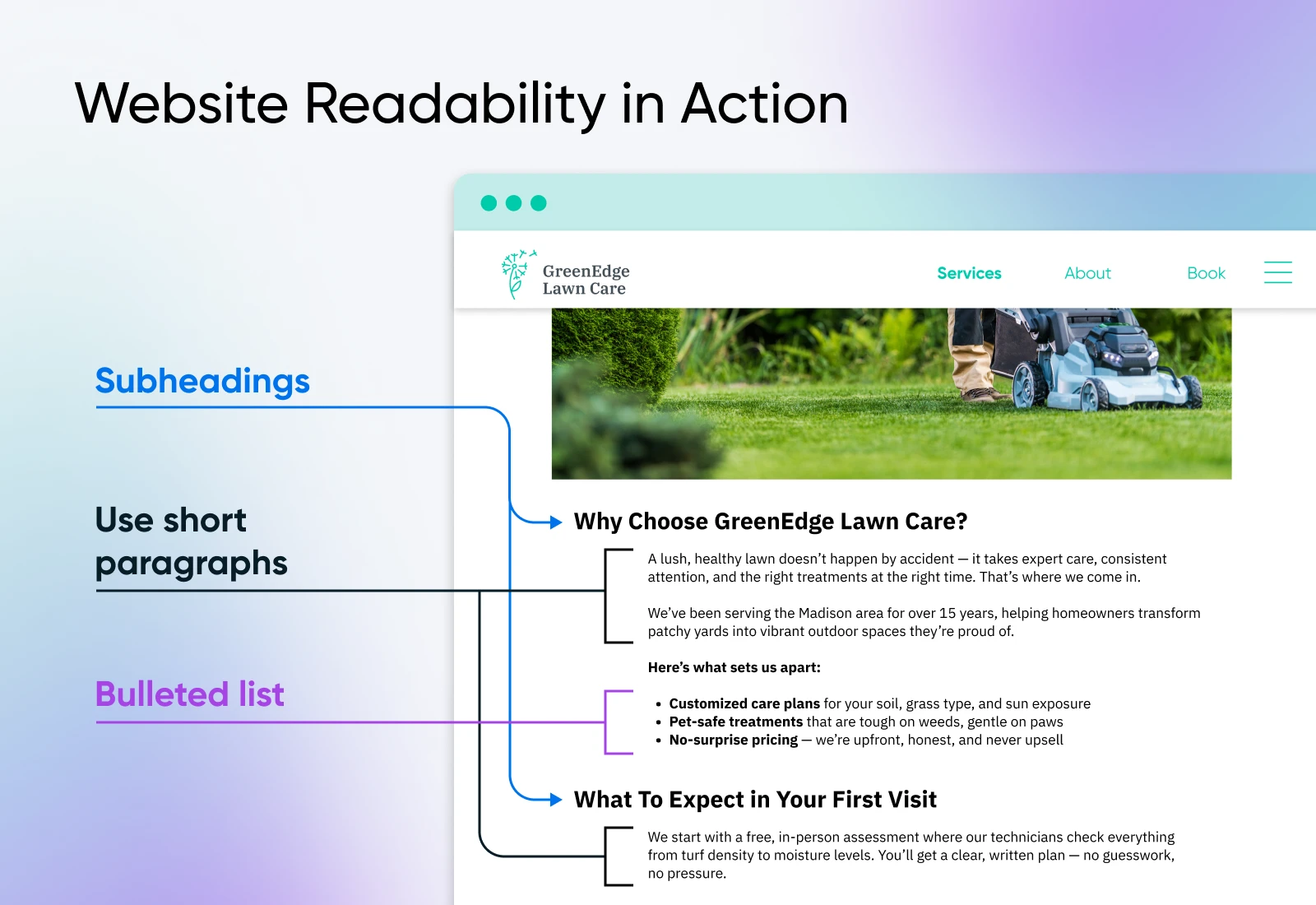
6. Embrace Eye-Catching Visuals
Your viewers kinds a primary impression of your web site in just some seconds,and visuals play an enormous position in how that impression is formed.
These photos, movies, graphics, and icons aren’t only for ornament. They’re instruments to speak info, seize consideration, break up textual content, and reinforce your message.
Strategic visuals assist your web page really feel extra participating and simpler to digest, encouraging customers to scroll as a substitute of bounce.
The underside line: Don’t add photos for the sake of filling area, however use them to strengthen your message and information the reader’s eye by way of the web page. Achieved proper, visuals cut back bounce price by making your web site really feel extra approachable and simpler to have interaction with.
What to do:
- Use high-quality, related photos that assist the content material. Keep away from generic inventory images when doable. Photographs that replicate your model, product, or crew construct extra belief.
- Incorporate screenshots, product images, or step-by-step visuals to clarify complicated processes or software program.
- Use infographics to visualise information, comparisons, or frameworks. These are nice for growing time-on-page and shareability.
- Embrace movies (embedded responsibly in order that they don’t gradual load instances) to clarify your product, demo a function, or share testimonials.
- Write informative captions in your photos. Captions are among the many most-read textual content on a web page and might improve understanding.
- All the time use descriptive alt textual content to assist accessibility and search engine optimisation.
7. Enhance Content material High quality
You may gown a webpage up with quick loading instances, glossy navigation, and delightful visuals, however readers will nonetheless bounce if the content material isn’t helpful. Take into consideration content material as a dialog along with your ideally suited buyer. Would they stroll away from that dialog feeling such as you helped them, or that you simply simply rambled with out providing something helpful? Nice content material reduces bounce as a result of it proves you’re value listening to.
The underside line: Content material high quality is the spine of consumer expertise. It’s the way you earn belief, present worth, and compel guests to discover extra.
What to do:
- Write along with your target market in thoughts. Use the language they use, reply the questions they ask, and converse to their wants, not simply your options.
- Outline a transparent goal for every bit of content material. Is it to tell, convert, entertain, or information? Construction it round that objective.
- Go deep. Fluffy content material crammed with imprecise generalities received’t maintain individuals engaged. Use particular examples, actionable recommendation, stats, quotes, and actual insights.
- Keep away from key phrase stuffing and awkward search engine optimisation writing. Write naturally for people first.
- Preserve content material updated. Outdated posts can lead customers to mistrust your model. Set a calendar to revisit prime posts often.
8. Optimize for Cell
In case your web site doesn’t work effectively on smartphones and different cellular units, you’re turning away nearly all of your visitors. In accordance with Statista, greater than 60% of worldwide internet visitors comes from cellular units. A web site that’s troublesome to make use of on cellular —suppose too-small fonts, damaged layouts, or buttons too small to faucet — will push customers away earlier than they even give your content material an opportunity.
The underside line: Even small cellular expertise frustrations can result in large bounce issues, so prioritize your cellular guests by giving them a quick, frictionless expertise that matches or exceeds what they’d get on desktop.
What to do:
- Select a responsive design that robotically adjusts to completely different display screen sizes. Most fashionable themes for WordPress and different platforms are responsive by default.
- Take a look at each essential web page in your smartphone. Don’t simply verify if it masses. As a substitute, verify if it’s readable, clickable, and usable.
- Be certain that fonts are giant sufficient (no less than 16px) and line spacing isn’t cramped.
- Use giant, clearly outlined buttons and faucet targets. No person needs to pinch-zoom simply to click on “Purchase Now.”
- Optimize photos and movies for cellular in order that they load shortly and don’t break the structure.
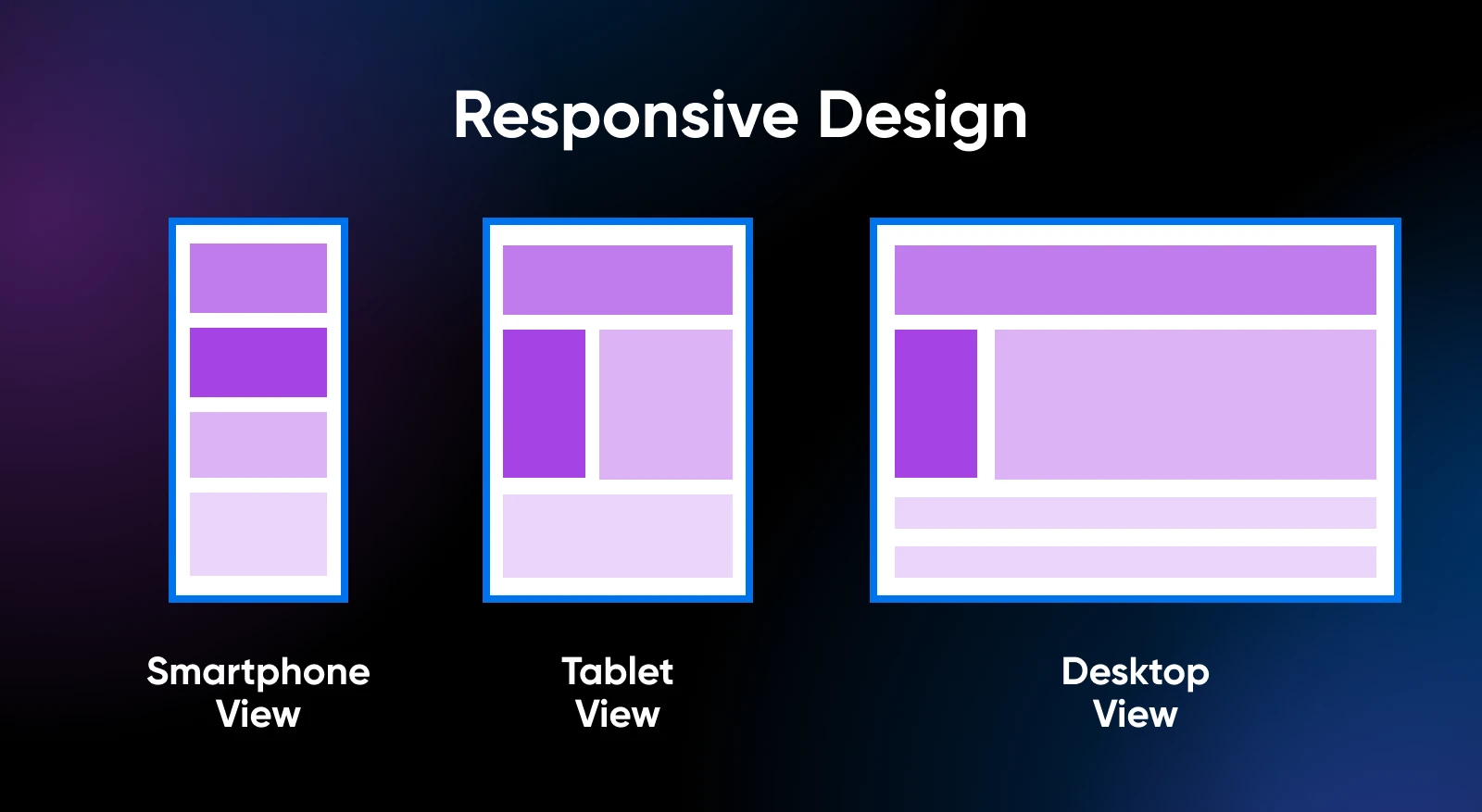
9. Enhance Web page Load Pace
Each second counts. Actually. In accordance with Google, 53% of cellular customers abandon a web site that takes longer than three seconds to load. It doesn’t matter how good your content material is — in case your web page masses slowly, most individuals received’t stick round to see it.
The underside line: A quicker web site means happier guests and fewer bounces.
What to do:
- Take a look at your web site with Google PageSpeed Insights or GTmetrix, and goal for a load time below three seconds.
- Compress photos earlier than importing utilizing instruments like TinyPNG or Squoosh. Massive picture recordsdata are one of many prime causes of gradual load instances.
- Use a content material supply community (CDN) to serve static recordsdata from servers nearer to your customers.
- Minify your web site’s CSS, JavaScript, and HTML to remove pointless code.
- Improve your internet hosting if wanted. Shared internet hosting can battle below visitors surges; VPS or managed WordPress internet hosting from DreamHost can dramatically enhance load instances.
10. All the time Be Testing
Each web site is completely different. What works for one viewers would possibly flop for an additional. The one option to know what actually resonates is to check it. Ongoing testing helps you repeatedly refine your web site’s efficiency and cut back friction at each step.
The underside line: A/B testing helps you make choices primarily based on proof, not assumptions.
What to do:
- Begin by figuring out one ingredient to check: a headline, CTA button, hero picture, or web page structure.
- Use instruments like Convert or Optimizely to run A/B assessments and measure outcomes.
- Apply learnings from one web page throughout different related pages.
Give Guests What They Got here For
From aligning your content material with customer intent to bettering readability, navigation, and web page velocity, each tip on this information is designed that can assist you create a smoother, smarter expertise. Bounce price might seem to be simply one other quantity in your analytics dashboard, however behind that quantity are actual individuals attempting to resolve in case your web site is value their time.
The takeaway? Don’t chase decrease bounce charges for the sake of vainness metrics. Concentrate on delivering what your viewers wants, clearly, shortly, and persistently. The higher your web site serves your guests, the extra time they’ll spend with you.
And if you would like a quick, dependable, and versatile internet hosting setup that may assist all these methods, try managed WordPress internet hosting from DreamHost to construct a better-performing web site that retains guests coming again for extra.

Professional Providers – Advertising and marketing
Get Extra Guests,u2028 Develop Your Enterprise
Our advertising and marketing specialists will show you how to earn extra visitors and convert extra web site guests so you’ll be able to deal with working your small business.
Did you get pleasure from this text?

